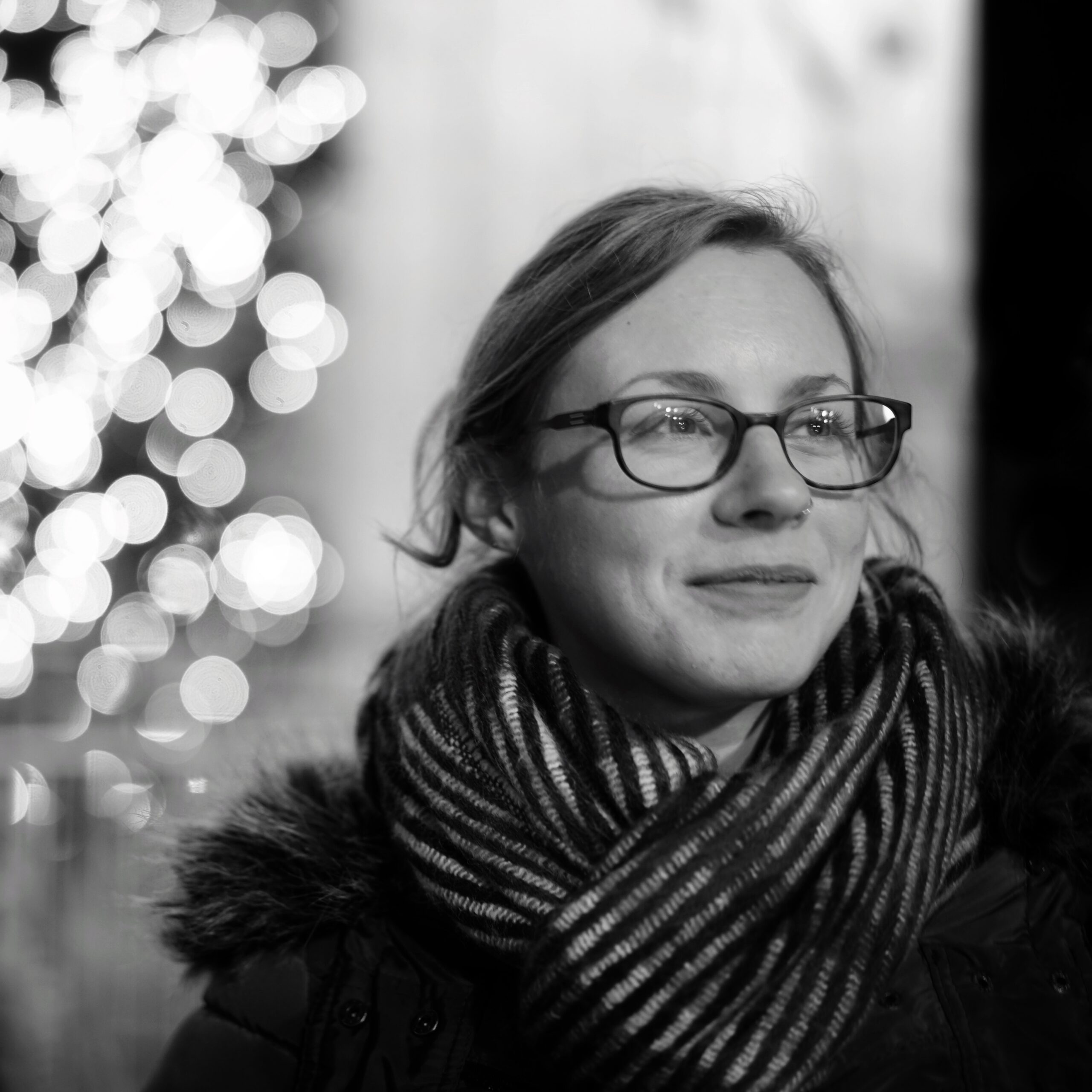
by Erin Calabria
It is a grey afternoon in Germany. It is almost always a grey afternoon in Germany, and my ears are buried in headphones, as they so often are these days, because there is nowhere to go right now, and no way to get there. So instead, I’m scrolling through voice memos, teleporting through sound. It takes me to my parents’ porch in Massachusetts, a spring morning fresh and twinkling with windchimes and birdsong. To the subway platform near one of my old jobs in New York, the notes from a busker’s xylophone floating in the relative quiet between trains, round and suspended through the air like soap bubbles. Then to high Spanish mountains in summer, a tide of bells rippling against stone peaks just before the sun goes down.
As a person fascinated with sound—in writing, music, audio production, and just in the world all around—it’s embarrassingly easy for me to forget what sound really is. So often cushioned within the interiority of headphones, of packaged, digitized files, I begin to forget that sound, like light, is a physical thing. That it moves in waves, in three-dimensions. That it travels through and stirs everything around it.
For a hearing person like me, it’s also easy to forget that rhythms and sonic patterns are neither exclusively for our ears nor only perceived by them. With the ubiquity of music in Deaf culture, it shouldn’t be so easy to forget that vibrations are not only heard, but felt. Sound is also tactile. Spatial.
Perhaps more than sound itself, it is this spatial quality of sound that interests me most in relation to craft: the shape that sound arranges around us, how it overlaps, varies, repeats. In the field of acoustic ecology, R. Murray Shafer coined a number of words to define spatial components of sound in the environment: terms like “keynotes” for underlying background, “sound signals” for attention-grabbing foreground, “hi-fi” to describe a diverse, highly differentiated space (like a rainforest), or “lo-fi” to describe a densely concentrated, homogenous space (like the white noise of a city).
Shafer also wrote about “soundmarks”—the sonic equivalent of landmarks—and how, as part of the physical structure of our environment, sound threads itself into a sense of place. The acoustic landscape of a place—its soundscape—immerses us in sounds both absent and present, in a non-linear whole that surrounds and locates us in space, in our various geographies, in our particular rooms. For me, sound has always felt like a place to visit. Which is something I could also say about stories.
The first stories I ever knew reached me through sound: a voice reading words from pages I couldn’t yet decipher, filling the room with the story, filling me in turn. Spoken aloud, the story was everywhere, touched everything, all at once.
When I was growing up, our mother continued to read books to my brother and me long after we were able to read them ourselves. In the dim, quiet hours before sleep, we would gather on my parents’ bed, a soft, blue sea of blankets folding us together as our mother read, conjuring forth the story, making it live in the world around and within us.
Remembering this now, I can’t help but feel a hitch in my chest: the innumerable hours my mother spent imparting these stories to us when she could have been doing almost anything else; and how, despite the storms that swept through our house, there was for most of the years I lived under its roof a calm shore we could return to, a place where the sound of stories belonged as much as wind and waves belong to the ocean.
These days, I think that is the kind of place I am trying to go now when I read and write stories. I can’t help but recall these lines by Dorianne Laux: “for each of us there is / Some small sound like an unseen bird or / A red bike grinding along the gravel path / That could wake us, and take us home.” Or else these words, from Arundhati Roy: “The Great Stories are the ones you have heard and want to hear again. The ones you can enter anywhere and inhabit comfortably. […] They are as familiar as the house you live in.”
Like most places, a house tends to be a complex, multifarious thing. There are the familiar stacks of books, letters, magazines, the cupboards glinting with mismatched mugs, the photo collections and random treasures: beach-combed shells, old postcards, hawk feathers. A house’s soundscape might encompass the whirr and tumble of a dryer, the drip of an upstairs shower, the chirping of birds at feeders outside. Though time passes in a house, though the light and the sounds within it change throughout the day, a house is more often perceived as spatial rather than temporal; a house’s history, the memories it evokes—even these exist all at once, outside of time and almost tangible, a patina over every surface. A house is a physical, layered place, one that holds us, one that we can move about and abide within.
Stories can be like this. Even if our eyes typically follow text in a linear fashion, the shape of a story is immersive, three-dimensional. Like a soundscape, it contains all kinds of silence, distance, echo. But I don’t really mean this from an exclusively oral/aural perspective, or even an analytical one; I’m not trying to make a direct comparison between Shafer’s acoustic vocabulary and storytelling, and I’m not really thinking about literary terms like meter, assonance, or consonance either, though these of course can play a role in a story’s structure.
What I’m trying to talk about is the wholistic experience of reading and writing, which, for me at least, is less like following a line on a blank page and more like lingering through a place, perhaps exploring a series of rooms or a patch of woods, but always letting your awareness pick up what else exists or might be missing in the space around you, recognizing patterns as they form and break, connecting the story’s pieces into various constellations, connecting with them. Dwelling.
Jane Alison writes that “although we think of narrative as a temporal art, experienced in time like music, of course it’s interestingly visual too; a story’s as much house or garden as song.” For my own purposes, I might substitute the word “spatial” for “visual,” but the idea of story as house or garden, as a place made to spend time in, rings true for me in a way that many traditional views on craft rarely have.
Maybe this is because people can also be like places inside. We can be just as cluttered as any house, as overgrown as any late summer garden, a riotous collage of emotions and sensory perceptions, memories and imagination. Stories cannot help but to be embodied—to exist as part of the bodies that hold them—and when we tell a story, there is so much more going on, so much more within us than a coherent scroll of text. And while we ultimately decide what and how much to tell in the end, to me the common English 101 refrain that “writing is a series of choices” has always perpetuated the single-mindedly linear, object-oriented, Freytag’s pyramid approach which leaves out the most human part of giving or receiving a story: listening.
Most grey afternoons, when I take a break from the page, I put down my headphones and go to the window. I turn off the radiator and tilt the pane open so I can hear the blue tits and chaffinches in the trees, the occasional chime of a bicycle, the cathedral bells tolling from across the highway. These sounds bring me back to the story and the place I am living right now. But listening, like sound, is not just about hearing. It is more about attention and being with: an abiding, which connects to abode, to dwelling. Sometimes I just listen to this place, here, where I am. And sometimes I abide with the story I am writing, noticing the shape of it the way I might with any soundscape, how the story’s elements are arranged in the space it both inhabits and creates, perhaps listening for at least one note that might call a person home, over and over again.
Sources/Further Reading:
Alison, Jane. Meander, Spiral Explode: Design and Pattern in Narrative. Catapult, 2019.
Laux, Dorianne. “Morning Song.” The American Poetry Review. Vol. 32, No. 6, November/December 2003, pp. 53-54. JSTOR, https://www.jstor.org/stable/20682420.
Roy, Arundhati. The God of Small Things. Fourth Estate, 1997.
Shafer, R. Murray. The Soundscape: Our Sonic Environment and the Tuning of the World. Destiny Books, 1993.
Wrightson, Kendall. “An Introduction to Acoustic Ecology.” Soundscape: The Journal of Acoustic Ecology. Vol. 1, No. 1, Spring 2000, pp. 10-13. World Forum for Acoustic Ecology Journal Archive, https://www.wfae.net/journal.html.
Read Erin’s other work at Reckon:
Fiction: Lampyridae

